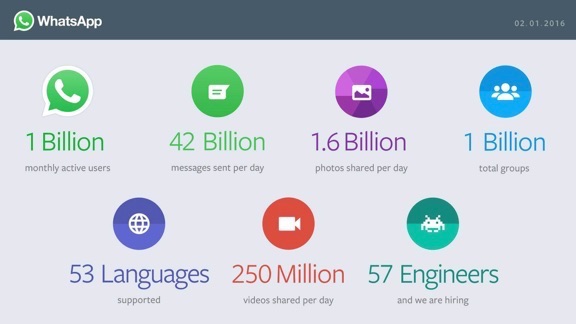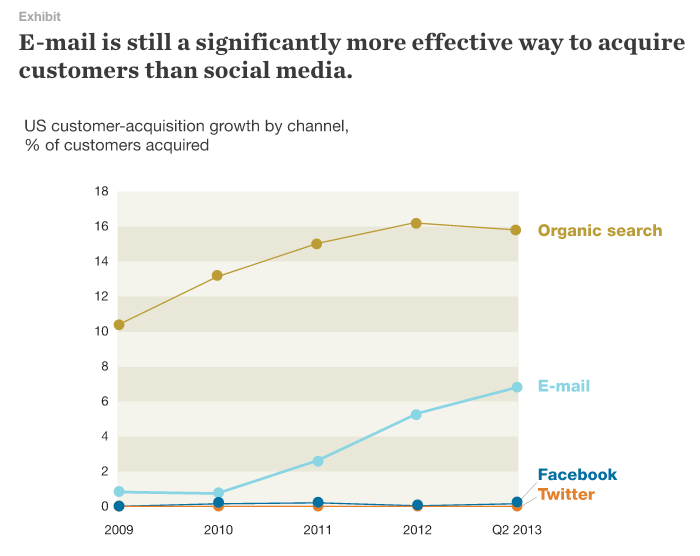Chatbots are the latest in a long line of tech trends to sweep through the marketing world.
One use and it's delightfully obvious why.
Ranging from fun and whimsical to straight-up commercial, chatbots present interesting new potential for companies to reach and engage customers.
Facebook messenger bots specifically present one of the brightest areas for marketers, tapping into their huge network and built-in advertising features.
However despite the promising outlook, you might be better served by ignoring this trend (for now).
Here's why.
The Promising Future of Facebook Bots
Chatbots magically combine pattern matching (low-level artificial intelligence) to present options to users instantly based on a number of predefined rules.
Based on your real-time responses, a chatbot will work to get you closer to finding exactly what you're looking for. That intent-driven nature makes it especially promising for marketers, showing a glimmer of hope similar other intent-based (not to mention, high converting) platforms like search engines.
Chatbots on Facebook messenger have been begun popping up everywhere the past few months, with help from platforms like Motion.ai and Smooch.io that help bridge the technological gap for the masses.
Expanding into Facebook's existing advertising infrastructure is mouth-watering. For example, you're able to integrate existing SMS messaging campaigns to Facebook Messenger accounts with phone number tracking.
There's also the potential for these chatbots to replace 800-numbers and other awful customer service experiences in favor of a real-time, at-your-fingertips, information retrieval system.
That's not even taking into account the massive potential that is WhatsApp (and its 1 billion monthly users), which Facebook owns, but doesn't currently allow this technology.

Some companies are already tapping into these benefits, as Andrew Tate highlights excellently on AdEspresso.
HealthTap allows you to speak directly to a doctor. Well, not exactly. It will start by showing you recommended answers from doctors to similar questions made in the past. Depending on your results, you can then send the question out to a real, live doctor to get an answer.
Spring gives you personalized shopping recommendations. List of questions for styles, price range, type of clothing and more to eventually whittle down its answers. This wonderful little chatbot does all the hard work for you, removing the need to browse for hours on end.
And one of the most cited examples 1-800 Flowers, where you can make a new order with a simple message. Enter the location for drop-off, and you can browse their options to make a purchase immediately. (although it's worth noting that you currently can't process credit card payments within Messenger).
Awesome stuff. No doubt.
But here's the problem.
Despite their awesome potential, chances are, you should NOT worry about chatbots right now.
Where do Buyers Come From?
In what seems like decades ago (ok, it was only about five years), Forrester Research analyzed over 77,000 consumer orders and released The Purchase Path of Online Buyers.
The goal was to determine which channels were responsible for the most buyers (not subscribers) to help marketers decide where to invest their precious resources.
The results were surprising exactly how you'd expect if you've been doing this for awhile.
Social accounted for less than a percent of sales (although in fairness, there's undoubtedly a host of attribution problems).
Otherwise, Search (both Paid and Organic) was the top driver of new sales. Email was at the top for repeat customers.
Fast forward a few years and McKinsey found that things had… well, not changed at all.

The way people purchase today has become increasingly more complex, with multiple touch points and many different channels used along the way. Many marketers struggle with getting a handle on understanding their own customer journeys.
The point though, is that there are a few fundamental things that should be working flawlessly before spending time, money and attention chasing the latest trend (despite how promising this particular one is).
Here are a few examples.
Here's Why You Should Ignore Facebook Bots (For Now)
Why do people leave your site?
Somewhat surprisingly, it could be how sloooooooooow pages take to load. If an eCommerce site fails to load within three seconds than half of its traffic will bounce.
Then there's also poor design and navigation issues, too many competing or cluttered offers, and a mismatch between what got people there, and what's on the page. Along with a ton of other reasons.
What's the reason you should forget about Facebook messenger bots for the next few months?
Opportunity cost.
Exhibit A.
McKinsey also found that despite the majority of visitors opening your email on mobile devices, many of the landing pages people are being sent to still aren't responsive.
(Not to mention, just because a website is 'supposedly' or technically responsive, doesn't mean that the mobile experience doesn't suck.)
To make matters, 61% of those people with bad experiences won't return. While 40% will go straight to your competition.
That means not only are your landing pages costing you lost sales. But they're also serving as your competitor's best advertisements.
Fixing those landing pages should be important. Priority #1 in fact when you go in on Monday morning. It should at least place well ahead of dabbling in new social features which may, or may not, pan out.
Based on data and experience, you know – beyond a shadow of a doubt – that improving landing pages will result in greater conversion rates (and thus, more revenue).
You just haven't done it yet.
Because, to-do lists. Emails. Meetings. Etc.
Exhibit B.
Every good little marketer uses email. It's like PB&J at this point. But, it too is under some strain.
Competition is at an all-time high (and only getting worse), so getting your messages to stick out from the other junk in people's inboxes is a tall order.
Then there's deliverability issues, which email service providers getting ever-more sophisticated to noticing (and filtering out) your promotional emails.
A handy and helpful solution is marketing automation, that relies on timing, relevancy and personalization to cut through the crap.
On the plus side? It works. Delivering twice as many leads compared with your typical spray-and-pray approach.
The downside? Only 13% of marketers are using it. 13%!
Despite the fact that marketing automation can send you 451% more leads. Or increase average sales 34%.
Case-in-point: a whopping 85% of B2B marketers are not satisfied with their marketing automation efforts. Even despite marketers ranking it at the top of a latest survey from Smart Insights of digital activities with the greatest impact.
Wait. Why? Too busy Snapchatting or Instagramming to worry about increasing revenue?
But it gets better.
Exhibit C.
Let's see what happens if we combine the activities found in Exhibit A & Exhibit B.
Williams-Sonoma saw a 10x lift in response rates when they sent triggered emails based on specific things people were just looking at on the website.
(Pro tip: Williams-Sonoma is also a great place to score free coffee at the mall using their Nespresso display.)
Personalized campaigns “consistently and overwhelmingly beat” static ones after analyzing 650 multi-channel marketing campaigns.
HubSpot analyzed 93,000 calls-to-action (with “hundreds of millions of views over 12 months”) and found that ones targeting specific user actions resulted in a 42% improvement over standard ones showed to everyone.
This is the same approach remarketing takes, personalizing ad creative while capitalizing on impeccable timing to show people exactly what they were just looking at. At a 46% reduction in cost compared to normal ads to boot.
Want a trend to follow? There's your trend!!
Conclusion
Chatbots are undoubtedly one of the sexiest trends to watch develop.
Facebook messenger bots up the ante, initially promising a huge opportunity with their massive audience and built-in advertising features.
However…
What keeps getting pushed down your to-do list already? How many activities have you neglected (or ignored) that could (and more predictably) increase revenue over the next 30 days?
Poor mobile landing pages? Tired, boring email campaigns? Static website calls to action?
If you're working with Coca-Cola, go get you some Facebook bots!
If you're like the rest of the 99% of us and you're (a) already overwhelmed, (b) spread too thin, (c) understaffed, (d) on too tight of deadlines, with (e) not enough money to spend, maybe it's time to double down on the fundamentals.
Fix the underperforming stuff you're (most likely already) aware of. Increase sales.
Then go play with some Facebook bots.
About the Author: Brad Smith is a founding partner at Codeless Interactive, a digital agency specializing in creating personalized customer experiences. Brad's blog also features more marketing thoughts, opinions and the occasional insight.
No comments:
Post a Comment